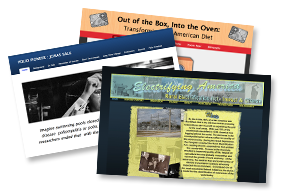Community Embraces New Word Game at Mid-Year Play Day This past Sunday, families at Takoma Park’s Seventh Annual Mid-Year Play Day had the opportunity to experience OtherWordly for the first time. Our educational language game drew curious children and parents to our table throughout the afternoon. Words in Space Several children gathered around our iPads […]
Read moreAuthor: IDEA
Computers and the internet are an increasingly important way that Americans engage in the arts, says a new report from the National Endowment for the Arts. The first bar in the chart below is people consuming recorded or broadcast content:

 Bad presentations abound, but it’s particularly egregious when presenting to public audiences. Text-heavy slides? Score! Confusing graphics? Score! Too many slides? Score! Have fun at your next presentation with Bad Presentation Bingo, a game developed by Monica Metzler, president of the Illinois Science Council. Check out the game… (more…)
Bad presentations abound, but it’s particularly egregious when presenting to public audiences. Text-heavy slides? Score! Confusing graphics? Score! Too many slides? Score! Have fun at your next presentation with Bad Presentation Bingo, a game developed by Monica Metzler, president of the Illinois Science Council. Check out the game… (more…)
 Blog networks provide readers an interesting place to read a variety of interesting articles, or other media. They can be win-win for everyone. Technically, they are relatively easy to make with the current generation of blog authoring software. It’s the human side that takes time and work. Here’s an example of how not to go about recruiting contributors for a blog network.
Blog networks provide readers an interesting place to read a variety of interesting articles, or other media. They can be win-win for everyone. Technically, they are relatively easy to make with the current generation of blog authoring software. It’s the human side that takes time and work. Here’s an example of how not to go about recruiting contributors for a blog network.
 America’s teachers are paying $480 million dollars out of their pockets to feed our kids. Earlier this week, Share Our Strength, a nonprofit working to end childhood hunger in America, reported that “61% of teachers who see children coming to school hungry because they are not eating at home purchase food for their classrooms, at an average of $25 a month.”
America’s teachers are paying $480 million dollars out of their pockets to feed our kids. Earlier this week, Share Our Strength, a nonprofit working to end childhood hunger in America, reported that “61% of teachers who see children coming to school hungry because they are not eating at home purchase food for their classrooms, at an average of $25 a month.”
 Patrons at 150 local libraries have a new option to borrow eBooks on their computers or iPad. Yesterday, Internet Archive launched a cooperative of libraries who are pooling resources to make eBooks available to their patrons. Patrons can now borrow any of 9,313 eBooks which have been purchased or scanned by any of the participating libraries. (more…)
Patrons at 150 local libraries have a new option to borrow eBooks on their computers or iPad. Yesterday, Internet Archive launched a cooperative of libraries who are pooling resources to make eBooks available to their patrons. Patrons can now borrow any of 9,313 eBooks which have been purchased or scanned by any of the participating libraries. (more…)
 On the screens of millions of iPad and other mobile devices, moons and stars, elements and molecules swirl beneath our fingertips. Developer Mike Howard says he wants to “make you feel like you are actually there in orbit.” Theodore Gray wants you to look at the periodic table and be transported to the world of Harry Potter, feeling as “if you checked out a magical version of The Elements from the Hogwarts library.”
On the screens of millions of iPad and other mobile devices, moons and stars, elements and molecules swirl beneath our fingertips. Developer Mike Howard says he wants to “make you feel like you are actually there in orbit.” Theodore Gray wants you to look at the periodic table and be transported to the world of Harry Potter, feeling as “if you checked out a magical version of The Elements from the Hogwarts library.”
Apps represent a shift in how students and the public learn about science. Currently, the best science apps are not being created by museums, traditional publishers, or curriculum developers — They are being created by enthusiastic solo developers, research centers, and new software companies with a penchant for science and public education. We’ll look at what motivated these app creators, what it took to make the apps, and how successful they have been. (more…)


 This weekend, I was a judge at a local chapter of
This weekend, I was a judge at a local chapter of  Blogging is an increasingly important way for the public to learn about science and culture. Bloggers fill in the information gaps, as traditional publishers slash jobs for science and arts journalists. More important, for good or bad, bloggers remove the gatekeepers (editors, press officers) which previously stood between experts and the public.
Blogging is an increasingly important way for the public to learn about science and culture. Bloggers fill in the information gaps, as traditional publishers slash jobs for science and arts journalists. More important, for good or bad, bloggers remove the gatekeepers (editors, press officers) which previously stood between experts and the public. Museums increasingly realize that if they want government funding and support, they need to make a case for it, and get their voice heard. So today and tomorrow is ‘
Museums increasingly realize that if they want government funding and support, they need to make a case for it, and get their voice heard. So today and tomorrow is ‘